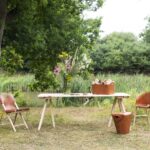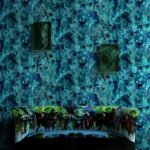Trying to peer into the future to see where home decor and design is going is to look in the wrong direction, suggests Aleem Kassam, an interior designer partner at Vancouver, BC-based Kalu Interiors.
Because we’re spending more time indoors, and more time alone, Kassam thinks we’re turning our collective gaze backward—fondly—to a simpler time. He sees a connection between that new reality and a rise of interest in natural forms and finishes.
“No matter where you live or what the landscape,” says Kassam, “one constant is that environment.” That’s why, he adds, incorporating natural and earthy materials, motifs, patterns, colours, and themes in interior design creates a sense of calm.
Meika McCunn agrees. “I grew up in a very rural area, so for me being in nature was a big part of my life. When I see materials that reflect nature, it brings me back to that place.”
A senior associate at Thomas Payne Architect, the Toronto-based practice Payne opened after many years as a founding partner at Kuwabara Payne McKenna Blumberg (KPMB) Architects, McCunn (who also worked at KPMB) brought a love of natural materials to renovations done on Koerner, Massey, and Minnesota Orchestra Halls.

locally-sourced materials.
“In Koerner Hall,” she says, “the shapes and the forms had to do with acoustics of the room. But there was a familiarity with the wood and the softness of the curves—the association of these things with nature brings people joy and comfort, I think,” she says.
To create those kinds of visual links in their own home renos, both are looking to a nature-inspired new collection from Dekton—an ultra-compact material made by Spanish company Cosentino from raw materials from porcelain, glass, and quartz.
The collection includes four new colour stories, including the Liquid Series, a design riff on the fluidity of liquid created in collaboration with Anna Murray and Grace Winteringham of U.K. design studio PATTERNITY .
McCunn says the material “made so much sense to me and my lifestyle—to be able to take a pot from stove to countertop and not worry about cracking or surface marking, or to be able to clean it with virtually any cleaning product.”
On top of that, says McCunn, “it’s absolutely beautiful.”
Both like that the material comes in multiple thickness and can be installed vertically or horizontal. And though it’s man-made, both give it high marks for sustainability.

“Eight nine years ago, we were all doing low-VOC paint, bamboo floors, solid wood for cabinetry. Not all those practices were sustainable—there were a lot of glues and adherents versus today, when we use waste in a way that gives materials a second life.”
Take note: Dekton can be installed in large-format tiles to create a seamless surface.
Composite stone, says McCann, has durability going for it. “Stone lasts through time. The idea of sustainability isn’t just seen in terms of green material now, but in terms of longevity,” says McCunn.
The feature picture in the title panel is Dekton’s Liquid Sky.






